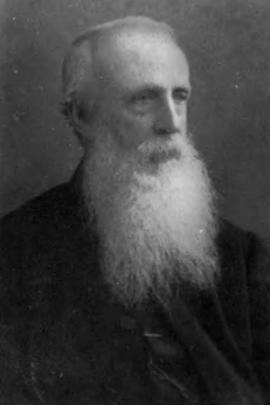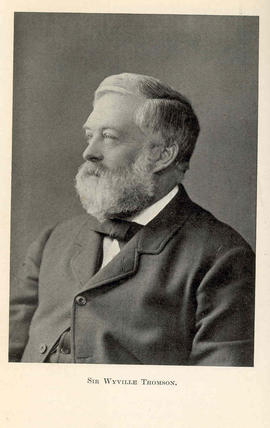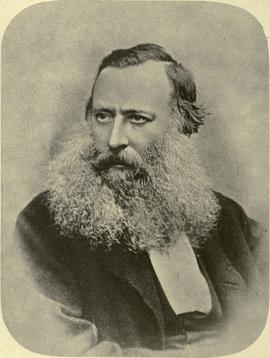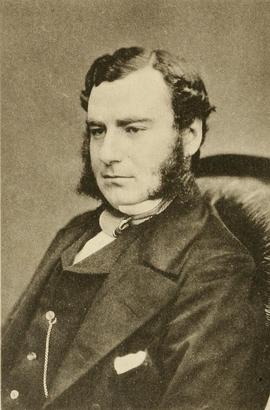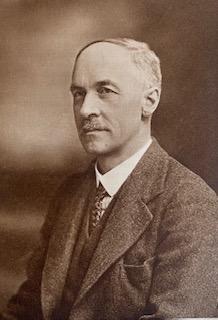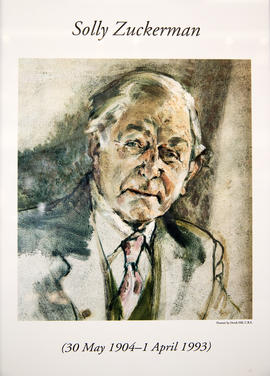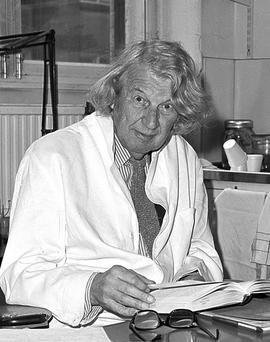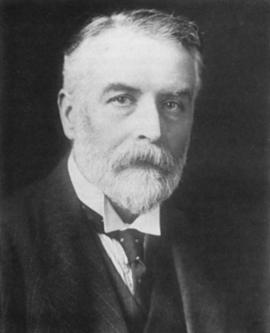Octavius Pickard-Cambridge was an English clergyman and zoologist. His main interest was in spiders, though he wrote also on birds and lepidoptera. He published extensively on spiders between 1859 and his death in 1917, including in the the journal of the Zoological Society of London. He became a world authority of spiders, describing a considerable number of new species including the Costa Rican redleg tarantula and the Sydney funnel-web spider
Sir Charles Wyville Thomson was a Scottish natural historian and marine zoologist. He served as the chief scientist on the Challenger expedition. His work there revolutionised oceanography and led to his knighthood
Sir Sidney Frederic Harmer was a British zoologist. He was President of the Linnean Society 1927-1931 and was awarded the Linnean Medal in 1934. He was Superintendent of the Cambridge University Museum of Zoology from 1892-1908, Keeper of Zoology at the Natural History Museum from 1909 to 1921 and director of the Museum from 1919 to 1927. His research library is held in the National Marine Biological Library at the Marine Biological Association in Plymouth
Edward Blyth was an English zoologist who worked for most of his life in India as a curator of zoology at the museum of the Asiatic Society of India in Calcutta. In 1841 he travelled to India to become the curator of the museum of the Royal Asiatic Society of Bengal. He set about updating the museum's catalogues, publishing a Catalogue of the Birds of the Asiatic Society in 1849. He remained as curator until 1862, when ill-health forced his return to England. His Natural History of the Cranes was published posthumously in 1881. Avian species bearing his name include Blyth's hornbill, Blyth's leaf warbler, Blyth's hawk-eagle, Blyth's olive bulbul, Blyth's parakeet, Blyth's frogmouth, Blyth's reed warbler, Blyth's rosefinch, Blyth's shrike-babbler, Blyth's tragopan, Blyth's pipit and Blyth's kingfisher. Reptilian species and a genus bearing his name include Blythia reticulata, Eumeces blythianus, and Rhinophis blythii
Alfred Newton was an English zoologist and ornithologist. Newton was Professor of Comparative Anatomy at Cambridge University from 1866 to 1907. Among his numerous publications were a four-volume Dictionary of Birds (1893-6), entries on ornithology in the Encyclopædia Britannica (9th edition) while also an editor of the journal Ibis from 1865 to 1870. In 1900 he was awarded the Royal Medal of the Royal Society and the Gold Medal of the Linnaean Society. He founded the British Ornithologists Union
David Seth-Smith was a British zoologist, wildlife artist, broadcaster and author. His career included spells as Curator of Mammals and Birds for the Zoological Society of London and editor of the Bulletin of the British Ornithologist's Club and the Avicultural Magazine. He also presented nature programmes on the BBC's Children's Hour under the name 'The Zoo Man', and also ''Friends from the Zoo' on BBC Television in the 1930s. He illustrated and photographed many animals and birds in captivity and is credited with taking the only known photographs of the now extinct pink-headed duck.
By 1945, he was a Fellow of the Royal Zoological Society, Member of the British Ornithologist's Union, Hon. Fellow, New York Zoological Society; Corresponding Fellow, American Ornithologists' Union; and Corresponding Member, Societe National d'Acclimatation de France.
Solomon 'Solly' Zuckerman was a British public servant, zoologist and operational research pioneer. He was born in Cape Town in 1904, the second child of Moses and Rebecca Zuckerman (nee Glaser). Both his parents were the children of Jewish immigrants from Russia. He was educated at the South African College School. After studying medicine at the University of Cape Town and later attending Yale University, he went to London in 1926 to complete his studies at the University College Hospital Medical School.
He began his career at the Zoological Society of London in 1928, and worked as a research anatomist until 1932. It was in this period that he founded the intellectual dining club, Tots and Quots. In 1932, he published his work 'Social Life of Monkeys and Apes'.
He taught at the University of Oxford from 1934 to 1945, during which time he was elected to a Fellowship of the Royal Society.
He was a scientific advisor to the Allies on bombing strategy in the Second World War, for his work to advance the cause of nuclear non-proliferation, and for his role in bringing attention to global economic issues.
Zuckerman married Lady Joan Rufus Isaacs in 1939 and they had two children. He died in London in 1993 following a heart attack.
Hampton Wildman Parker was an English zoologist. Parker was Keeper of Zoology at the Natural History Museum from 1947 to 1957. He was the author of several on snakes and frogs. He discovered a new species of of lizard on the Seychelles, which he described and named Vesey-Fitzgerald's burrowing skink (Janetaescincus veseyfitzgeraldi) after entomologist Leslie Desmond Foster Vesey-Fitzgerald
John Zachary Young was an English zoologist and neurophysiologist
George Albert Boulenger was a Belgian-British zoologist who described and gave scientific names to over 2,000 new animal species, chiefly fish, reptiles and amphibians. In 1880 he was invited to work at the Natural History Museum, then a department of the British Museum, and assigned to the task of cataloguing the amphibians in the collection. He was also an active botanist during the last 30 years of his life, especially in the study of roses. His son, Edward George Boulenger, was also a zoologist and held the post of Director at the ZSL London Zoo Aquarium
